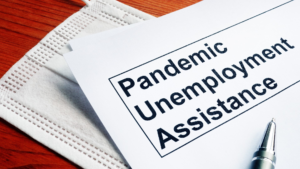Pandemic Related Unemployment Benefits Have Ended. Now What?
 On September 4th, the pandemic-related unemployment benefits offered by the federal government ended. Those included:
On September 4th, the pandemic-related unemployment benefits offered by the federal government ended. Those included:
- Pandemic Unemployment Assistance (PUA), for many left out of traditional unemployment;
- Pandemic Emergency Unemployment Compensation (PEUC), which extended the weeks for regular unemployment;
- Federal Pandemic Unemployment Compensation (FPUC), an additional $300 a week for all claimants; and
- Mixed Earners Unemployment Compensation (MEUC), an additional $100 to certain workers.
It’s a loss for so many vulnerable individuals and families struggling to put food on the table. In Massachusetts alone, more than 300,000 people have been impacted. There are many reasons individuals who lost unemployment are not able to access work right now – including child care barriers, lack of access to remote work jobs for those who are immunocompromised, concerns regarding the Delta variant of COVID-19, and more. For those who are able to access work, the hours or pay may not be consistent or pay a living wage. Benefits from the Department of Transitional Assistance (DTA) are a critical tool to ensure individuals and families can put food on the table.
So now what?
Many may qualify for SNAP and TAFDC benefits through the Department of Transitional Assistance. Most low-income households are eligible for SNAP monthly food dollars. During COVID, it is worth noting that SNAP benefits are higher! For example, an eligible family of two with income below $2,903 a month gets at least $459 in SNAP.
TAFDC cash assistance is for pregnant people and families with children with no or very low income – up to $712 per month for a family of three. According to data from the Commonwealth’s Department of Unemployment Assistance (DUA), about 150,000 people who lost all of their unemployment benefits also received the dependent allowance, meaning they have at least one child. And while TAFDC benefits are lower than unemployment benefits, they provide both an economic bridge and a pathway to other important services. For example, TAFDC connects families to free childcare for those who can locate a childcare slot. Families who apply by the end of September also qualify for a $350 clothing allowance per child.
The Massachusetts Law Reform Institute (MLRI) and our partners such as Greater Boston Legal Services are working hard to ensure that low-income households are aware of these resources. Visit this page to download plain language fliers in five languages on SNAP and TAFDC, along with information about additional resources for families.
There is significantly more that can be done by the Baker Administration. Around September 10 – the time where most claimants were connecting with the Department of Unemployment Assistance (DUA) about the loss of these federal unemployment benefits – DUA removed all language about DTA benefits or other resources from their website, and in their weekly email to claimants on September 10 did not tell families about these critical benefits.
We are disappointed the Baker Administrative has not been more proactive about sharing critical resources with struggling families. We encourage the Executive Office of Labor and Workforce Development (EOWLD) and DUA, along with other key state agencies, to robustly inform households who lost unemployment about these benefit programs. Ensuring all low-income households can put food on the table benefits the Commonwealth by bringing federal dollars to our communities, improving health outcomes, and supporting our collective public health.
And of course, we will continue to work hard at the local, state, and federal levels to make sure robust supports are in place for those who have been harmed the most by this pandemic.
